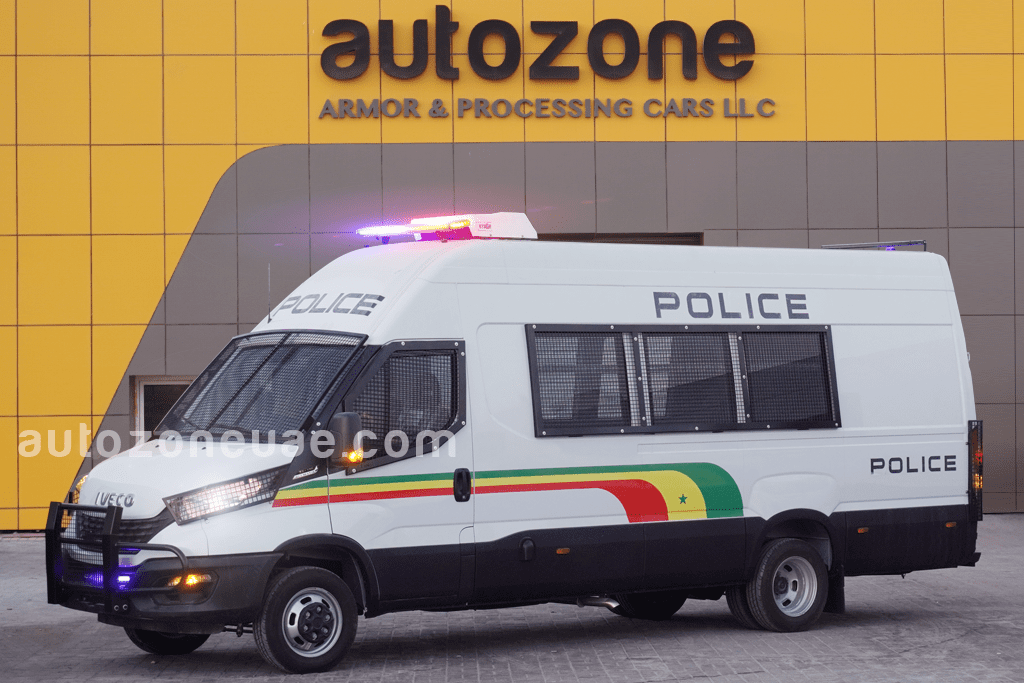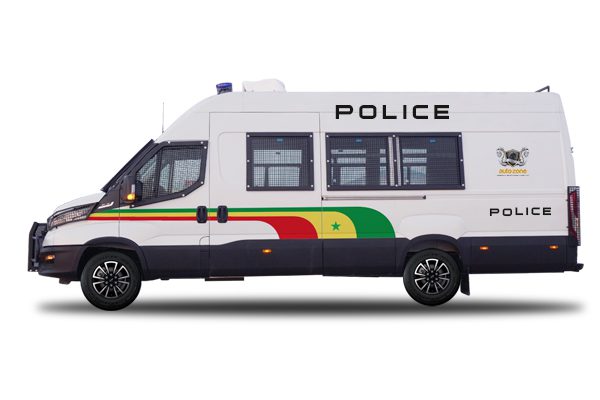Law enforcement agencies are the backbone of public safety and justice, tasked with maintaining order, upholding the rule of law, and safeguarding communities. In their daily operations, officers face a myriad of challenges, and their commitment to ensuring the safety and security of all citizens is unwavering. Among the many tools and resources at their disposal, one often overlooked yet undeniably crucial aspect of law enforcement is the use of prisoner transport vehicle.
These unassuming vehicles quietly serve as the workhorses of the justice system, responsible for securely and efficiently transporting individuals who law enforcement has detained or arrested. While they may not always capture the spotlight, prisoner transport vehicles play a vital role in the delicate balance between maintaining public safety and upholding the rights of detainees.
In this blog post, we will delve into the indispensable role of prisoner transport vehicles in the realm of law enforcement. We will explore how these specialized vehicles, equipped with unique features and designed with precision, contribute to the core principles of justice, human rights, and the efficient functioning of law enforcement agencies.
As we embark on this journey, we invite you to gain a deeper appreciation for these unsung heroes of law enforcement, understanding their critical role in creating a safer and more secure society for us all. Let us shine a spotlight on “The Vital Role of Prisoner Transport Vehicles in Law Enforcement.”
Ensuring Public Safety of Prisoner Transport Vehicle
In the realm of law enforcement, the safety of the public, officers, and detainees takes precedence above all else. When law enforcement detains or arrests an individual, they must move the individual from one location to another, whether it’s from the scene of an incident to a police station, a courthouse, or another facility. We cannot overstate the importance of this transportation process, as it involves multiple risks and challenges that prisoner transport vehicles are specifically designed to address.
Secure Transportation
The primary objective of this vehicle is to ensure secure transportation. This entails not only preventing detainees from escaping but also safeguarding them from potential harm and minimizing any risks to the public and law enforcement officers.
Detainees who are transported in standard vehicles or without proper security measures can pose significant threats. They may attempt to escape, become violent, or cause damage to the vehicle, creating dangerous situations for all involved. This vehicle is equipped to mitigate these risks effectively.
Specialized Features
Prisoner transport vehicles are meticulously designed with a range of specialized features aimed at enhancing security during transit. These features include:
Reinforced Doors:
This vehicle typically has reinforced doors that are designed to withstand tampering and resist forced entry. This ensures that detainees cannot breach the vehicle’s integrity.
Secure Partitions:
A secure partition separates detainees from law enforcement officers, preventing physical contact and reducing the potential for confrontations and altercations.
Specialized Restraints:
These vehicles have specialized restraints that securely fasten detainees to their seats, minimizing their ability to move or cause harm to themselves or others.
By combining these features and more, these vehicles provide a controlled and secure environment during transit, significantly reducing the likelihood of incidents that could compromise public safety.
In the next section, we will explore how prisoner transport vehicles also play a crucial role in protecting the rights of detainees, ensuring their well-being, and upholding principles of human rights and justice.
Protecting the Rights of Detainees
While prisoner transport vehicles are essential for maintaining public safety. They also play a vital role in upholding the rights and dignity of detainees. Treating individuals with respect and providing a safe and secure environment during transport is paramount, regardless of their legal status. This section delves into the critical aspects of prisoner transport vehicles that protect detainees’ rights and well-being.
Respecting Human Rights
Central to the operation of the vehicle is the principle of respecting human rights. All detainees, regardless of the circumstances of their arrest, deserve fundamental human rights and dignity. Designers of prisoner transport vehicles incorporate these principles into their designs, ensuring fair and just treatment of detainees.
Equal Treatment:
Prisoner transport vehicles ensure that all detainees are treated equally, regardless of their background, gender, or any other factors. This promotes fairness and justice within the criminal justice system.
Dignity and Respect:
Detainees are transported in a manner that upholds their dignity and respect. This includes maintaining a clean and sanitary environment within the vehicle and providing necessary amenities.
Well-Designed Environments
The design of prisoner transport vehicles also contributes significantly to protecting detainees’ rights. Designers equip these vehicles with features that ensure the well-being of detainees during transit, preventing issues such as overcrowding, discomfort, and excessive force.
1. Adequate Ventilation:
Designers of prisoner transport vehicles design them to provide adequate ventilation. Ensuring that detainees have access to fresh air throughout the journey.
2. Proper Lighting:
Well-lit interiors contribute to the safety and well-being of detainees. Adequate lighting enables officers to monitor detainees effectively and ensures that no one experiences undue darkness.
3. Seating Arrangements:
Prisoner transport vehicles feature secure and comfortable seating arrangements that minimize the discomfort of detainees during transit. Properly designed seats also prevent detainees from sliding or moving excessively.
By prioritizing these design elements, prisoner transport vehicles create an environment that respects detainees’ rights and well-being, maintaining a delicate balance between the interests of law enforcement and the rights of those in custody.
In the following section, we will explore how law enforcement operations enhance efficiency through the use of prisoner transport vehicles, optimizing resource allocation and response times.
Enhancing Efficiency in Law Enforcement Operations
Efficiency is a cornerstone of effective law enforcement, and law enforcement agencies must optimize every aspect of police work, including detainee transport, to ensure they allocate resources judiciously. In this section, we will examine how prisoner transport vehicles enhance the overall efficiency of law enforcement operations.
Streamlining Processes
Prisoner transport vehicles streamline the process of moving detainees from one location to another. This efficiency is particularly crucial in situations where time is of the essence, such as during emergency responses or court appearances.
1. Reduced Transit Time:
Law enforcement agencies can minimize the time spent on these tasks by using dedicated vehicles designed for detainee transport. This allows officers to respond more rapidly to other incidents and prioritize their duties.
2. Enhanced Officer Productivity:
Officers’ time is a valuable resource, and prisoner transport vehicles allow them to focus on their core responsibilities. Such as investigation and public safety, rather than dedicating excessive time to transport duties.
Resource Allocation of Prisoner Transport Vehicle
Efficient detainee transport directly contributes to more effective resource allocation within law enforcement agencies. This optimization allows agencies to enhance overall public safety by strategically allocating personnel, time, and vehicles to where they are needed most.
1. Faster Emergency Response:
With efficient detainee transport, officers can be available for emergency calls and critical situations more promptly, potentially saving lives and preventing crimes.
2. Improved Resource Management:
Law enforcement agencies can manage their resources more effectively. Ensuring that they strategically distribute the workforce and vehicles to cover a broader range of responsibilities.
In essence, prisoner transport vehicles are not just vehicles; they are tools that help law enforcement agencies operate more effectively, respond to emergencies faster, and maintain a high level of public safety. Their role in enhancing efficiency must be considered.
In the concluding section of this blog post, we will recap the crucial role of prisoner transport vehicles in law enforcement and call for an appreciation of their contributions to justice and security.
Conclusion
In the world of law enforcement, where order, justice, and public safety are paramount, prisoner transport vehicles stand as silent sentinels, performing an indispensable role that often goes unnoticed. As we reflect on their role, it becomes evident that these unassuming vehicles are the linchpin in the delicate balance between maintaining public safety and upholding the rights of detainees.
Prisoner transport vehicles are the guardians of secure transportation, ensuring that detainees reach their destinations without posing risks to themselves, officers, or the public. With reinforced doors, secure partitions, and specialized restraints, these vehicles create a controlled and secure environment that minimizes confrontations and maximizes security.
Simultaneously, these vehicles are bastions of respect and dignity, upholding the human rights of detainees during their journeys. Equal treatment, dignity, and respect are not just principles but tangible features within prisoner transport vehicles, providing a safe and humane environment for detainees.
Efficiency is another hallmark of the vehicle. By streamlining processes and optimizing resource allocation, these vehicles allow law enforcement agencies to respond more effectively to emergencies, allocate resources judiciously, and enhance overall public safety.
As we conclude this exploration of prisoner transport vehicle, we invite you to appreciate their vital role in law enforcement. They silently navigate the path between justice and security. Ensuring that they respect the rights of detainees while maintaining the safety of all.
In a world where law enforcement professionals strive tirelessly to protect and serve. Let us remember the essential role that prisoner transport vehicles play in upholding the principles of justice and creating a safer and more secure society for all.

 AR
AR FR
FR







